|
|
|
|
| How can I more effectively teach my primary students to communicate their learning in math with greater confidence; namely to express that learning clearly, using pictures, numbers and words? |
|
|
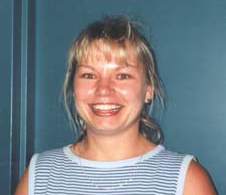 |
Biography
Much of my teaching experience has been working with early childhood students. I have taught preschool, kindergarten for seven years, and grades one and two for the past three years. Currently, I am a primaryteacher for the Grand Erie District School Board. I teach grade one and two at Northview Public School in Hagersville, Ontario. My post secondary education includes earning a diploma in Social Service Work,and a combined Bachelor of Arts Degree in Child Studies and Psychology. I later attended teacher's college and earned a Bachelor of Education Degree.
|
|
|
Abstract
I first became involved in Action Research in 2000. For many years, I had been interested in what is known as the Reggio Approach, an Italian city's approach to early childhood education. Reggio Emilia is renowned for its image of the child, how the child learns, and how s/he expresses that learning using many "languages".
Through Action Research, I want to continue to implement aspects of this approach into my program within the framework of the Ontario Curriculum. My work has led to in-depth investigations of children's drawings, portfolios, math journals, and the documentation process.
This project demonstrates that math journals are an effective means for grade ½ students to communicate their learning in math.
Defining The Question
I have used math journals in my teaching in past years; however, this year I was determined to use math journals more effectively in my classroom. My experience teaching early childhood and primary students has taught me that although young children may understand a concept in math, it is difficult for them to articulate that understanding. I wanted to use math journals in my grade one/two classroom as a means to encourage and teach my students to communicate their understandings in mathematics. I phrased my research question to reflect this objective. I asked, "How can I more effectively teach my primary students to communicate their learning in math with greater confidence; namely, to express that learning clearly, using pictures, numbers and words?"
Setting Up
I organized my classroom in September in such a way that all of the math resources and manipulatives were located at a learning centre. I prepared the math journals, which were simply a booklet of blank pages with a cover.
I planned the first activities in math purposefully so that the children could become familiar with classroom materials through basic sorting experiences. The students were given many opportunities for hands-on learning with the manipulatives . The children used classroom collections to practice sorting various materials into 'like groups'. During that first week of school, I introduced math journals to my students. I explained that this would be a place for them to make a record of their math work. The students first used math journals in early September to show sorting experiences. I gave my students the prompt, "In your math journal, show how you sorted the materials you worked with. Use pictures, numbers and words". I moved around the room, giving assistance when required.
I continued following this kind of format throughout the first term. Sometimes I asked the students to tell what they know about ..., other times I asked them to explain what they had learned about ..., still other times, I simply asked them to record new math vocabulary - for example "the pattern block shapes". Every time they made an entry, I would use the prompt, "Use pictures, numbers and words".
Providing Support Along The Way
|
 |
|
Brody had worked at a centre with coloured lids and unlabelled charts. In his journal, he drew a simple t-chart and labelled it with the colour words to show how he sorted the plastic lids.
|
|
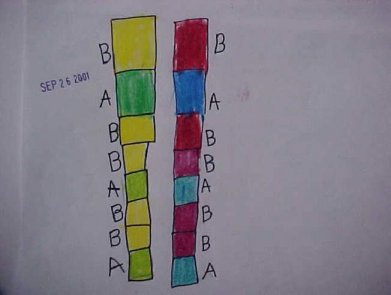 |
|
Sarah used unifix cubes to make patterns. She made a drawing of her patterns and labelled them in her math journal.
|
|
|
Grade one and two students are just developing in their ability to use written language. As well, they are being introduced to a lot of new math vocabulary throughout these first years. In the beginning, I expected that most journal entries would consist of pictures and perhaps some numerals. I expected the children to use math words orally at first and then progress to using math words in written form.
Early on, I realized the necessity of giving my students the "tools" they needed to communicate their learning. They needed to see the math words, the numerals, and the visual organizers to assist in picture making (e.g., T-charts, grids.). I first provided these "tools" by printing the needed math vocabulary on the blackboard, by drawing attention to the number line display in the room, and by providing the students with photocopied visual organizers when I felt that they would be helpful. I also made labelled work mats for the students to use with manipulatives and had these available at the math centre. By interacting with these visual organizers, I believed that the students would be exposed to models of what their math pictures might include.
|
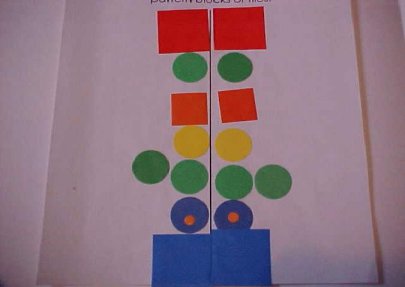 |
|
Brody’s symmetrical design is shown here to provide an example of a simple organizer given to assist students in their ‘picture making’. This page was simply divided in half lengthwise to create a mat upon which to build a symmetrical design with pattern blocks, tiles, or stickers.
|
|
 |
|
Sarah used a t-chart to show how she sorted two-dimensional shapes according to a given attribute; in this case, the number of sides.
|
|
|
Coping With Change
In mid-October, the physical location of my classroom changed. I moved to a larger room in the building with better air quality. The room had previously been the school library. Although very spacious and bright, the room was not set up to be a classroom. There was only one small blackboard and limited useful bulletin board space. It took some time to "settle in" and organize the classroom materials in an aesthetically pleasing yet functional and child-friendly manner. After the move, I organized all of the math materials into blue tubs, labelling everything at the centre. I believed it was important to have all of the math materials clearly labelled so that students could use those math words in their writing. Large number charts, and math posters were hung. Once again, the physical environment was set up to support student learning.
|
|
|
|
|
|
|
|
Modelling, Discussion, Scribing, Sharing
Children need many examples from which to learn. Often, our class completed a math journal entry together in a shared writing format before the children would be expected to complete an entry on their own. I encouraged a lot of discussion during journal writing time. This cooperative "math talk" environment provided the students with helpful opportunities to orally communicate their understanding of the math with their peers. Some students experienced difficulty with writing words. For those students, I scribed their words for them on the page. I responded to the children's writing/oral accounts with questions or comments that would extend their thinking. I provided time and opportunity for children to share their journal entries if they wished. I sometimes spotlighted a particularly good entry.
A New Tool
At the beginning of November, I created "Math Words" booklets for student use. These booklets were set up so that a math word was typed next to a picture icon representing that word; much like a picture dictionary but for math. They were designed so that new pages could be added as new math vocabulary was introduced. I also posted the same math words on our classroom word wall on blue paper so the math words were distinct from our other focus words. Now I believed that the children had the "tools" they needed to communicate their learning more effectively.
|
|
|
|
|
|
Examples of Booklets
|
Adding Math Words to the Word Wall
|
|
|
 |
Adding math words to the word wall served to assist the students in writing about their understanding of math concepts.
|
|
|
Determining The Most Appropriate Format
In mid- November, I implemented the idea of using a journal page which organized the components of a "good entry". I considered that a standard format may help the students to better organize their thoughts and therefore assist in the oral and written communication of their learning in math, so I developed a standard journal page. After a couple of revisions, I believed I had a good template. I designed the page so that it was divided into sections. The first section had a place for the problem and was headed with the question, "What is the problem?". The next section was for listing the materials used - "What I used", and the bottom portion was for "What I did". This is where the students needed to used pictures, numbers and words to communicate their understanding. There were two more sections: "What I learned" and "What I wonder". I intended to use these sections to record student comments during conference sessions. The students used this journal page several times. As they were working, I noticed that some of the students used the journal page as it was intended to be used and appreciated the directive. I noted that these students were my "readers".
|
 |
Nicole is a reader. She is an independent worker who performs very well in grade one. She confidently completed the above entry, demonstrating some higher order thinking. She writes, “I wonder if the pentagon always has to be like a house”.
|
|
| Many of my students, however, appeared to be somewhat stressed by the new format. They felt uneasy about having to fit their thinking into a predesigned form which was not meaningful to them or simply did not give them enough space to draw and write. |
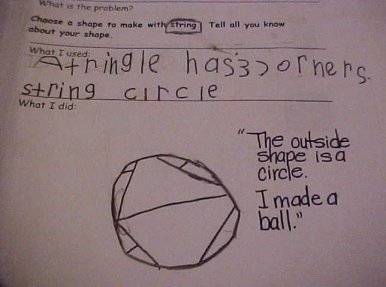 |
Justus could not read the headings. He felt confused and frustrated too. He said he felt like giving up. I helped him by scribing his words for him in his journal.
|
|
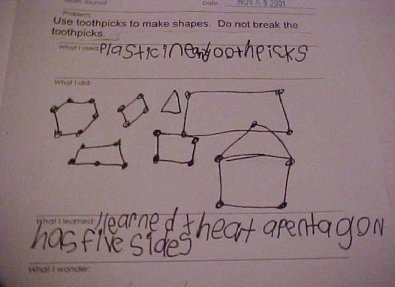 |
Brayden expressed frustration with fitting his ideas into the space provided.
|
|
|
Some children felt intimidated because they could not read all of the words on the page or concerned because having a standard form suggested one right way to show their work. I asked the children which format they preferred and why. Most of the children said they needed more space to do their work, and that the blank page was better for that. A lot of the children responded by saying, "the blank page" but they were not able to put into words why. Some did not respond at all. I ascertained the above conclusions by observing and listening to students as they worked and by conferencing with individual students. The format was problematic for me too, because at times I wanted to provide the students with blackline graphic organizers to support them in making a record of their work such as a T-chart, Ven diagram, or grid, and the new page format didn't allow for that. I concluded that by using this format I was pushing the children to perform at a level that many were not ready for. Perhaps this format would work more effectively in a grade three class. I went back to the more open method of having students "journal" what they were learning on a blank page or using a visual organizer. This format allowed the students greater freedom to perform at their own personal level and style.
The Children's Perspective
In December, I felt I needed a clear account of how the children were feeling, so I talked with them about using the math journals. Specifically, I asked them, "How do you feel about doing this kind of math; to show your learning in a journal using pictures, numbers and words?" The following were some of their responses:
Laurissa: "Sometimes it's fun."
Grant: "It's fun because you learn stuff and know a lot of words... Writing the words is hard. I get bored sometimes."
Jessica: "It's good. You get to learn a lot of stuff."
Shantelle: "You learn how to read. Like how to spell buttons... I don't like gluing stuff though."
Nicole: "I like it because you put pictures, numbers and words together to make a story."
Connor: "It's fun because you learn new words like the focus words."
Paul: "I like when we can do the pictures."
Brayden: "I think it's fun because we can learn a lot of stuff".
I felt that although my students and I had struggled with finding the most appropriate format for journal writing, I had set up the learning environment in such a way that most of the children were still feeling comfortable with writing in math class.
Observing Growth
By the end of January, the students in my class could be observed looking around the room to find the words they wanted to write during math class. They used classroom picture dictionaries, the Math Words booklets, the word wall, and even children's literature books which they knew had the spelling of a word they wanted. For example, when the class was working on finding half of a number using pasta and goldfish crackers, Alex went to the class-made rendition of Brown Bear, Brown Bear, What Do You See? to find the word goldfish to complete his journal entry. On other occasions, Brody asked Connor how to spell his name, Sarah was checking the "Math Words" booklet for the spelling of "half' and Grant was looking for the spelling of 'even' on the word wall. I was pleased to see that the children were transferring what they were learning about writing in the morning; pleased to see the same behaviours and use of strategies during math class in the afternoon! This was a positive development and I was excited to see such growth!
|
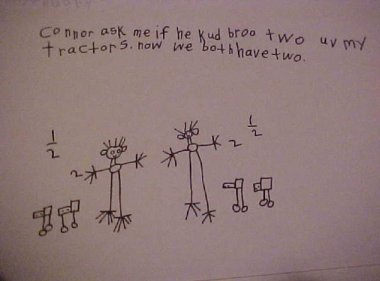 |
Brody wrote this simple story to show his understanding of the fraction one half. He writes, “Connor asked me if he could borrow two of my tractors. Now we both have two”.
|
|
|
|
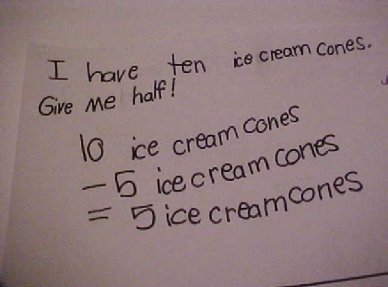 |
Sarah wrote this entry in January to show her understanding of the fraction one half.
|
|
 |
Grant was learning about number patterns and was making connections to even and odd numbers. He discovered that when you add two even numbers, you get an even answer and when you add an odd number to an even number, the answer is always odd.
|
|
 |
Sarah worked with Laurissa at a building centre. The task was to build three dimensional solids with multilink cubes. She writes: “We made a rectangular prism with 350 multilink cubes. We skipped by tens and we got to 350.”
|
|
 |
Nicole worked at a different centre. The task there was to create a three dimensional shape using toothpicks and plasticine. She writes: “I used toothpicks to make a cube and a cone. Now I am going to add another cube to make a rectangular prism.
|
|
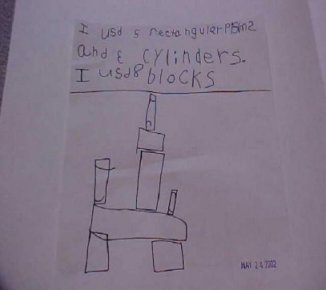 |
Brody worked at a building centre as well. The task was to build a structure using three dimensional solids. They were to tell what they did in their math journals.
|
|
|
By April and May, students were confidently writing in math class. They completed entries in less time, and were excited to share their responses with others.
Clearly, I had witnessed growth over the span of the school year. The children, too, realized growth and felt good about their accomplishments. Obviously some growth in the children's ability to communicate their understanding in math can be attributed to maturity. I believe that having the children express their understanding using pictures, numbers and words in a math journal was also a powerful contributing factor.
Evaluating The Journal Experience
The purpose of my research was to discover what methods were effective in getting children to think about and communicate their math understanding. I believe that communicating orally about ideas and understandings helps students to clarify concepts; therefore, providing opportunities for student discussion is crucial. Writing too, is a supportive medium that helps students to learn and understand mathematical concepts. By "writing it down", students are "forced" to think clearly about the math problem or concept. I learned that young students need certain "tools" and experiences in order to feel confident and successful in their "math writing". My class included many reluctant and early writers as well as a number of competent developing writers. The following objectives promoted success for each of these student groups:
- Create a comfortable atmosphere in which all students can succeed.
- Plan time for the exploration and use of concrete manipulatives.
- Provide many examples of work mats and visual organizers for students to use with manipulatives.
- Have "math words" accessible, providing students with the language they need to respond to a prompting question.
- Allow for variation of response. Recognize that there is no one "right" way of expressing understanding.
- Assess mathematical thinking, not the writing.
- Allow students to work collaboratively and talk as needed.
- Encourage sharing of responses.
At the end of May, I asked my students to complete the following prompt: "I know I have done a good job in my math journal when...". The following responses given by grade one students attest to the success of using math journals in the primary grades to promote the communication of math understanding.
|
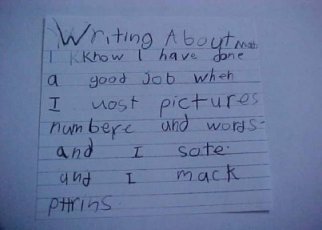 |
Danielle writes: “I know I have done a good job when I used pictures, numbers and words and I sort and I make patterns.”
|
|
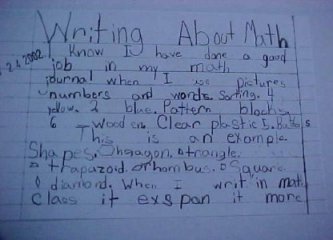 |
Nicole writes: “I know I have done a good job in my math journal when I use pictures, numbers and words. Sorting: 4 yellow, 2 blue - pattern blocks; 6 wooden, clear plastic 5 - buttons. This is an example. Shapes: hexagon, triangle, trapezoid, rhombus, square, diamond. When I write in math class it explains it more.”
|
|
 |
Brody writes: “I know I have done a good job in my math journal when I have been learning more things in math class. I like math class because it is fun.”
|
|
 |
Grant writes: “I know I have done a good job in my math journal when I used pictures, numbers and words. When I write about math, I learned more.”
|
|
 |
Laurissa writes: “I know I have done a good job in my math journal when I use a math word(s) from the math book and to sound out words and to look at the word wall.
|
|
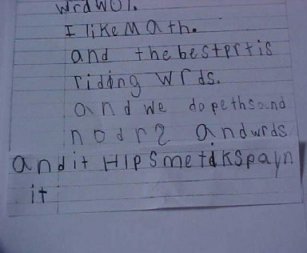 |
"I like math and the best part is writing words and we do pictures, numbers and words and it helps me to explain it."
|
|
|



